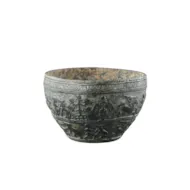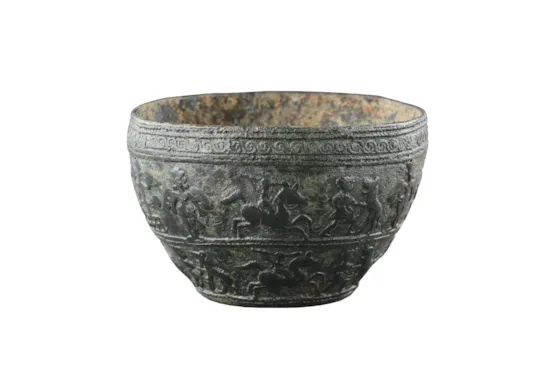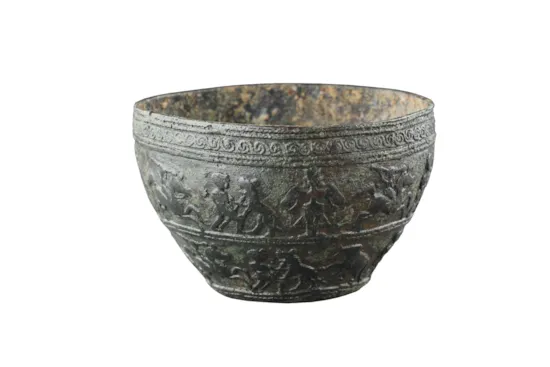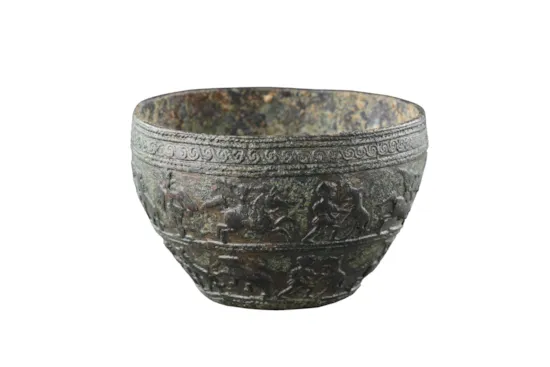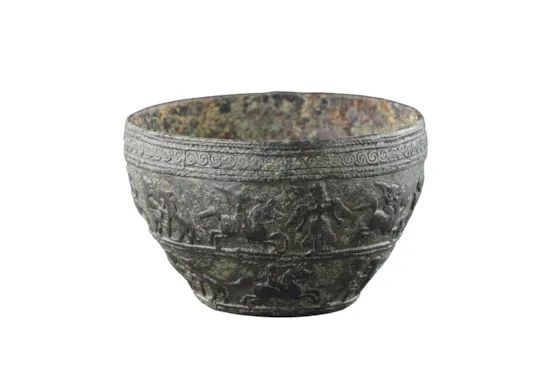A Very Rare Bronze Goblet Illustrating the Story of Prince Kunala
A Very Rare Bronze Goblet Illustrating the Story of Prince Kunala
Bronze
Arachosie / Eastern Persia / modern day Afghanistan / Pakistan border
Late 2nd - Early 1st Century BC
SIZE: 4.5cm high, 7cm dia. - 1¾ ins high, 2¾ ins dia.
Bronze
Arachosie / Eastern Persia / modern day Afghanistan / Pakistan border
Late 2nd - Early 1st Century BC
SIZE: 4.5cm high, 7cm dia. - 1¾ ins high, 2¾ ins dia.
A Very Rare Bronze Goblet Illustrating the Story of Prince Kunala
Bronze
Arachosie / Eastern Persia / modern day Afghanistan / Pakistan border
Late 2nd - Early 1st Century BC
SIZE: 4.5cm high, 7cm dia. - 1¾ ins high, 2¾ ins dia.
Bronze
Arachosie / Eastern Persia / modern day Afghanistan / Pakistan border
Late 2nd - Early 1st Century BC
SIZE: 4.5cm high, 7cm dia. - 1¾ ins high, 2¾ ins dia.
Published:
Jean-François Jarrige; Un Goblet Histoire de l’Ancienne Arachosie, Anamorphoses, Hommage à Jacques Dumarçay, Les Indes Savantes, 2006; Exhibition catalogue: ‘Every Object Tells a Story’, first published in 2017, and ‘The Silk Road’ catalogue, London 2018.
In a remarkable article, Jarrige has deciphered the meaning of the many figures around the circumferences of two goblets displaying the story of Prince Kunala and Queen Tisyaraksita, analysing these illustrations down to the smallest detail. The story was transmitted in the ‘Ashokavadana’, the text that did so much to burnish the image and legend of Ashoka. Anyone wanting a real understanding of this goblet, one of the finest to have survived, should consult the article. Queen Tisyaraksita was perturbed by the number of presents that her husband Ashoka was sending to the Bodhi Tree after his conversion to Buddhism, the Tree beneath which the Buddha received his Enlightenment, and imagined that there was a woman involved. She instructed a local witch to discover and destroy the object of her husband’s devotion: the Tree died, but such was Ashoka’s despair that she realised her error, and the Tree was revived, by reverse witchcraft. Ashoka had a son, Kunala, who, having grown up, married Kanacanamala. He had the most beautiful eyes, and Tisyaraksita tried to seduce him. Rejected, she had him blinded, so he became a wandering minstrel, accompanied by his faithful wife.
Ashoka had her executed once he learned the truth, against the wishes of Kunala, who maintained that he was repaying the karmic debt of blinding 500 deer in a previous existence. The Satrapy of Arachosie was founded by Alexander the Great, where Kandahar now exists. It retained its Hellenistic culture under the Mauryan dynasty, through the ‘satraps’ who ruled it, under whom all the diverse elements of different cultures came together, and were expressed. The legend of Ashoka and the story of Kunala were popular throughout the Buddhist world, from India to Japan.
Jean-François Jarrige; Un Goblet Histoire de l’Ancienne Arachosie, Anamorphoses, Hommage à Jacques Dumarçay, Les Indes Savantes, 2006; Exhibition catalogue: ‘Every Object Tells a Story’, first published in 2017, and ‘The Silk Road’ catalogue, London 2018.
In a remarkable article, Jarrige has deciphered the meaning of the many figures around the circumferences of two goblets displaying the story of Prince Kunala and Queen Tisyaraksita, analysing these illustrations down to the smallest detail. The story was transmitted in the ‘Ashokavadana’, the text that did so much to burnish the image and legend of Ashoka. Anyone wanting a real understanding of this goblet, one of the finest to have survived, should consult the article. Queen Tisyaraksita was perturbed by the number of presents that her husband Ashoka was sending to the Bodhi Tree after his conversion to Buddhism, the Tree beneath which the Buddha received his Enlightenment, and imagined that there was a woman involved. She instructed a local witch to discover and destroy the object of her husband’s devotion: the Tree died, but such was Ashoka’s despair that she realised her error, and the Tree was revived, by reverse witchcraft. Ashoka had a son, Kunala, who, having grown up, married Kanacanamala. He had the most beautiful eyes, and Tisyaraksita tried to seduce him. Rejected, she had him blinded, so he became a wandering minstrel, accompanied by his faithful wife.
Ashoka had her executed once he learned the truth, against the wishes of Kunala, who maintained that he was repaying the karmic debt of blinding 500 deer in a previous existence. The Satrapy of Arachosie was founded by Alexander the Great, where Kandahar now exists. It retained its Hellenistic culture under the Mauryan dynasty, through the ‘satraps’ who ruled it, under whom all the diverse elements of different cultures came together, and were expressed. The legend of Ashoka and the story of Kunala were popular throughout the Buddhist world, from India to Japan.
Art Market Sharjah, circa 1995
Ex John Kasmin Private collection
Ex Oliver Hoare Ltd.
Ex Private collection
Ex John Kasmin Private collection
Ex Oliver Hoare Ltd.
Ex Private collection
A Very Rare Bronze Goblet Illustrating the Story of Prince Kunala
